Notes Illustrated
Consistent Evidentiary Note-making
Sean Murphy*
Starting out
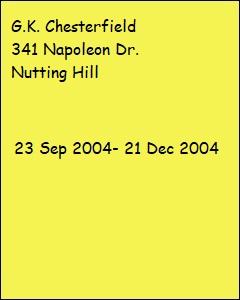
Full Text

Use the notebook only for professional note-making. Do not use it for non-professional purposes.
On the face of the notebook write your name and some contact information.
Write the date of the first entry.
When you reach the end of the notebook, add the date of the last entry.
This will allow you to keep a series of notebooks in order.
All entries should be in pen.
Structure
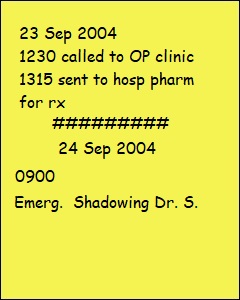
Each day
you use the notebook, begin by writing the current date.
Consistently use a clear, standard mark (like cross-hatching) at the end of a
day's notes.
Each entry during the day must begin with the time you made the entry.
This entry was made at 0900.
You can use standard or personalized abbreviations.
However, be sure that abbreviations are (1) consistent, (2) unambiguous, and (3) will be meaningful a year later. Was "Dr. S." Dr. Smith or Dr. Smithers?
Alternative structure with margin
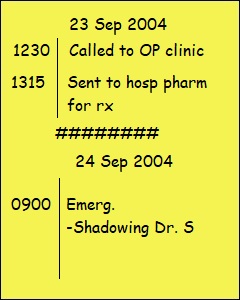
You may mark the time as a sub-heading (example above) or in the margin, depending upon the design of the notebook and your preference.
A margin is desirable because it
improves readability.
You can add a margin to a notebook that does
not have one.
Make entries easy to find
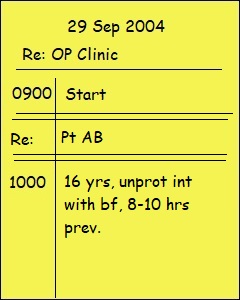
You can
use captions to identify different subjects or activities.
Consistently use some standard mark (like double lines) to divide one captioned section from
another of the same date.
Retrospective recording of an incident
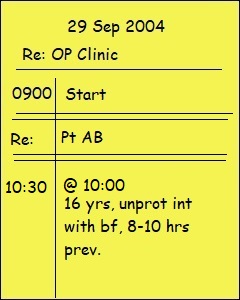
If you are making a note about something that happened earlier,
or if continuing notemaking that was interrupted
- begin with the present (entry) time
- include the time of the incident in the body of the note.
By doing this you will always be able to distinguish the time of the entry from
the time of the incident.
Here the note made at 10:30 refers to an
incident that happened at 10:00.
Note the abbreviation "unprot" indicates "unprotected".
Abbreviating this as "unp" would be ambiguous; does "unp" mean "unplanned" or "unprotected"? Would you remember a year later?
Do not back-date or back-time entries even with an innocent intention. Six months later
you will not remember whether the entry was made at the time noted, or
later. This will undermine the reliability of your notes and your
credibility.
Identify verbatim statements
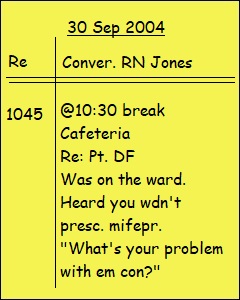
Do not put paraphrased notes of what was said in quotation marks.
Consistently identify
verbatim statements by using quotation marks.
Reserve
quotation marks for this purpose.

If a statement is almost
verbatim but some words may be uncertain, you can use quotation marks
qualified by "WTE" - meaning, "Those words or words to that effect."
Making corrections when making a note . . .
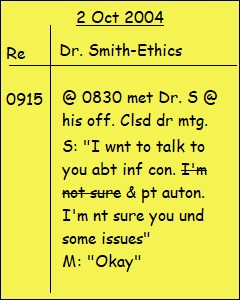
Errors detected while writing an entry should be corrected by striking out the mistake with a single line and writing in the correction.
Here, while writing the entry, you remember that Dr. Smith had said "informed consent and patient autonomy".
. . . or later
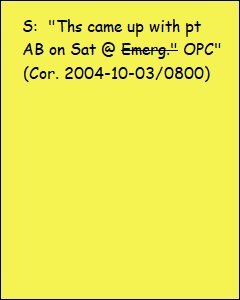
Errors detected later should be corrected the same way, but write the date and time of the correction next to
it.
Here, on re-reading the note the following morning, you realize that you made a mistake by writing "Emerg" instead of "OPC" (Out Patient Clinic, next door to Emergency)
When there is not enough room for correction. . .
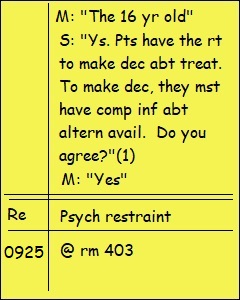
Sometimes there is no room to make a correction in the body of an entry, or you need to correct an omission.
Here, your retrospective note-making was interrupted by an urgent call for assistance.
You made notes about that and other unrelated matters.
You resume retrospective note-making later. When reviewing the initial entry you find an omission.
Mark the relevant passage with an end note: "(1)".
. . . use an end note.
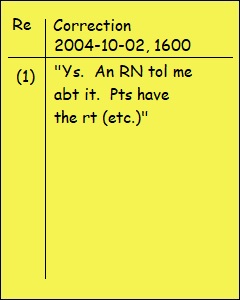
Place the end note with the correction in a later notebook entry, or on the back page of your notebook.
If you add end notes to the back page of your notebook, work from the back of the
notebook to the front when adding subsequent notes.
Do not use white-out,
correcting tape or erasers, and do not blot out or scribble over mistakes. These methods expose you to accusations that you are attempting to conceal something.
Be consistent
These are suggestions. You may adopt other methods
for structuring your notes, identifying verbatim statements or making
corrections. You should strive for consistency to ensure that your notes are
reliable and will withstand critical scrutiny.